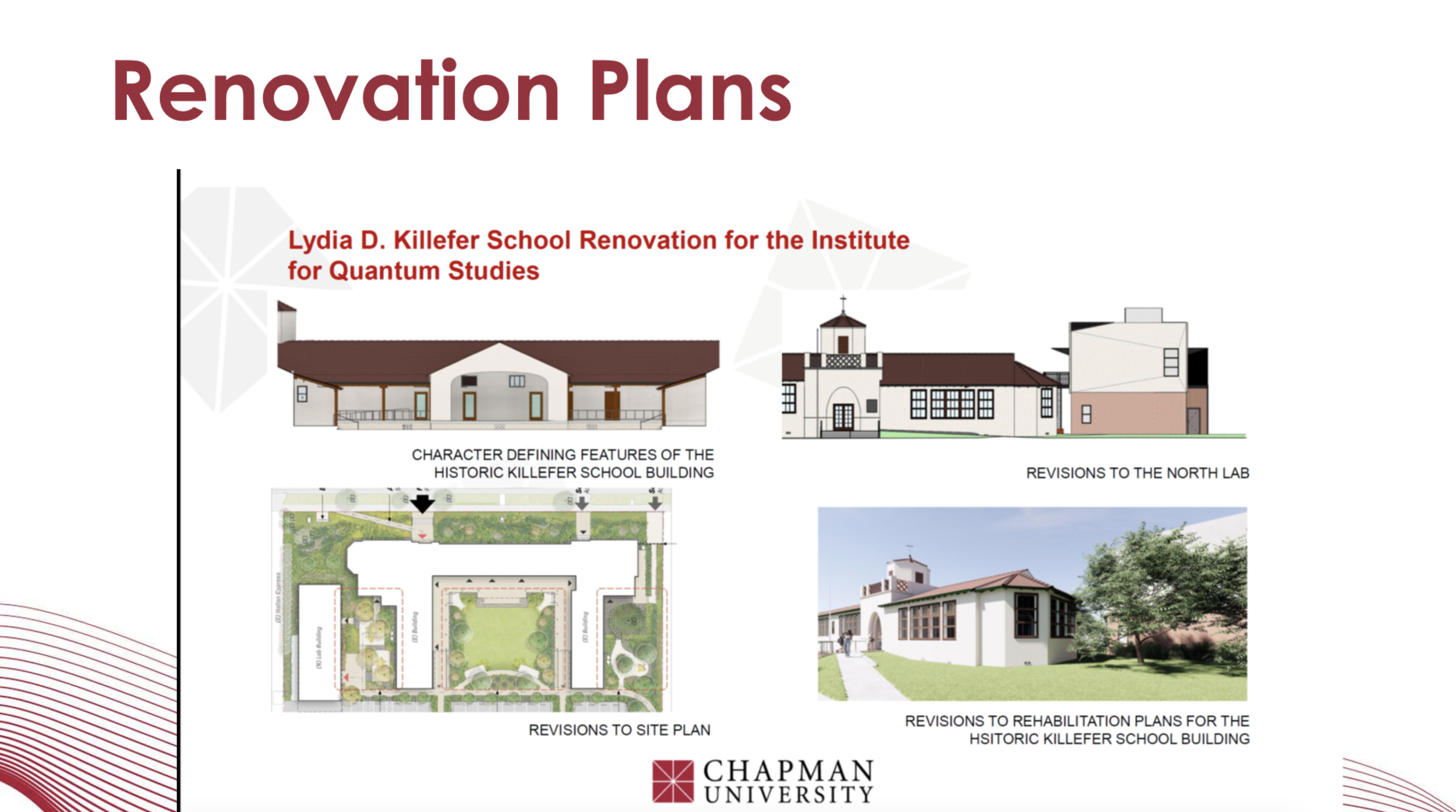Killefer building renovations to open new opportunities for research, engagement for Chapman University
The historic Lydia D. Killefer building is being renovated to house the Institute for Quantum Studies and the Advanced Physics Laboratory. Photo courtesy of EYRC Architects
The Lydia D. Killefer School building will be undergoing renovations beginning this fall semester as part of Chapman University’s 2023 to 2028 strategic plan. The Killefer building is a historic, nationally-registered landmark that was purchased by Chapman University in January 2020.
The building is most well-known for integrating in 1944, prior to the end of segregation in Orange County three years later. The exterior will be entirely preserved in the construction, while the interior will be reshaped to accommodate the university’s Institute for Quantum Studies (IQS) and the Advanced Physics Laboratory.
“Right now, our facility is inadequate for the kind of advanced optics research that we are conducting,” Chapman President Daniele Struppa told The Panther. “The new facility will allow our faculty to do more with the time they are in the labs, and (it) will allow students to participate in some of the more cutting-edge projects in quantum optics as well as superconductivity.”
The Killefer building’s survival is equally miraculous, as most Mexican schools were not preserved following desegregation. IQS Director Dr. Andrew Jordan explained that part of the renovations include restoration of the building’s exterior to better resemble its original form, built all the way back in 1931.
However, Jordan also noted that two outbuildings that are on the same lot as the Killefer building — which are not part of the school’s historic value — will be demolished. The spaces will be used for a two-story building to house Armen Gulian’s Advanced Physics Laboratory group. Gulian is the laboratory’s senior research scientist and director.
“I wanted the IQS to have a self-contained facility where all quantum-related activities (superconductivity, foundations of quantum and quantum optics) could be implemented,” Struppa told The Panther. “I wanted a place where our scientists could create a community of equally-minded intellects focused on these very complex problems.”
The renovations include better accessibility, research labs, offices, lecture halls and lounges. There is a focus on the community of Orange itself as well. The design will include exhibits open to the public, alongside an improved courtyard and outdoor area open to the public. It will also include a semi-public community room.
“Our relationship with the community is very important, first of all, because a successful university is a university that is seen as central to the well-being and success of the community,” Struppa said. “And second of all, because the goodwill of the community is central to us when we apply for new projects in the city.”
While there are plenty who approve of Chapman’s preservation of the Killefer building, others have expressed an urge to see the building turned into a community center or civil rights museum instead.
There is also skepticism regarding how open the building will be to the local community. Jordan stated that it would be possible for the community to hold events after hours given the building’s importance, but that the details would have to be sorted out at a later time.
“I imagine the effect of the exhibits would be minimal, but it might inspire young kids if they see the research labs as well,” said Michael Cheng, a junior electrical engineering major. “I think it would be beneficial to Fowler as more people would see the facilities we have.”
“I imagine the effect of the exhibits would be minimal, but it might inspire young kids if they see the research labs as well. I think it would be beneficial to Fowler as more people would see the facilities we have.”
With construction proceeding in compliance with local ordinances regarding hours of work and reduced noise levels, the building is expected to finish renovations in 2024. Jordan expects, with the current schedule, to make the Killefer building usable for the Institute and Laboratory in January 2025.
“The new space will give critically needed space for research, especially experimental research,” Jordan said. “Currently, the Institute members are scattered across campus, mostly in (the) Hashinger (Science Center) and in the Keck Science Center. By moving most of the Institute members to the historical Killefer complex, it also frees up space on the main campus for incoming faculty and students.”
Jordan also expressed that the Killefer building could host events beyond those involving the local community, with hopes that scientists from across the world could visit in order to discuss recent innovations in the fields of advanced physics and quantum science.
“As a scientist, I am excited about being able to offer educational events to the wider community,” Jordan told The Panther. “It offers new resources to the entire region, and especially our city.”
“As a scientist, I am excited about being able to offer educational events to the wider community. It offers new resources to the entire region, and especially our city.”

